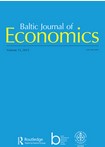Macroeconomic volatility, monetary union, and external exposure: evidence from five Eurozone members
Macroeconomic volatility, monetary union, and external exposure: evidence from five Eurozone members
Author(s): Scott W. HegertySubject(s): National Economy, Supranational / Global Economy, Economic history, Economic policy, International relations/trade, Comparative politics, Transformation Period (1990 - 2010), Present Times (2010 - today), EU-Approach / EU-Accession / EU-Development, Financial Markets
Published by: BICEPS/SSE Riga
Keywords: Macroeconomic Volatility; Structural Breaks; Eurozone; Central and Eastern Europe;
Summary/Abstract: Membership in a common currency area is thought to promote economic stability by facilitating macroeconomic convergence, but a country might give up important monetary policy tools that could help stabilize its economy following a shock. The effect of a common currency on macroeconomic volatility can therefore be ambiguous. This study examines five Central and Eastern European countries that joined the Eurozone since 2005; their differences, particularly with regard to the countries’ economic performance and pre-accession exchange-rate regimes, help drive a unique set of results. Structural breaks in the volatility of real output, consumption, and investment generally correspond to events other than Eurozone accession, and Vector Autoregressive methods show that global shocks have more of an impact on output volatility than do regional shocks or economic openness. Spillovers affect Latvia and Lithuania more than Estonia, Slovakia, or Slovenia, which suggests that a unified currency space might have difficulty managing idiosyncratic shocks.
Journal: Baltic Journal of Economics
- Issue Year: 20/2020
- Issue No: 2
- Page Range: 117-138
- Page Count: 22
- Language: English

